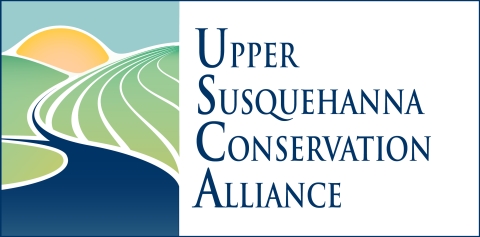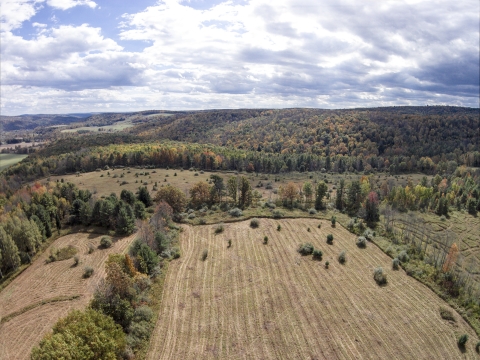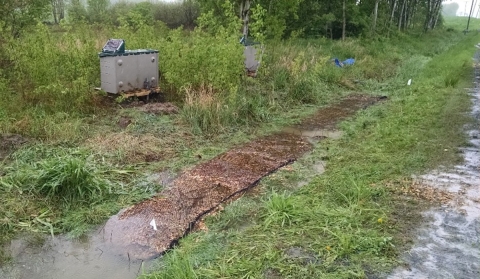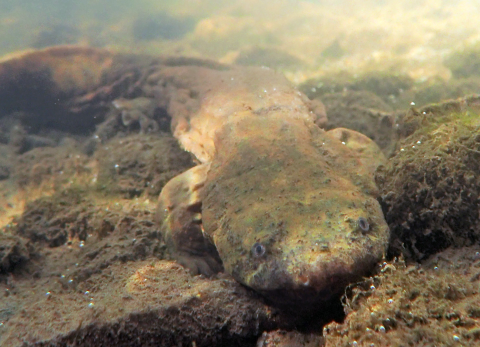What is the Upper Susquehanna Conservation Alliance?
The Upper Susquehanna Conservation Alliance (USCA) is an alliance of agencies, organizations, academic institutions, and individuals who are working collaboratively to conduct green infrastructure planning, implement restoration and maintenance of high quality waters and habitats, protect and restore species of greatest conservation need, reduce impacts of flooding, and promote sustainable working landscapes for the people of the watershed. Take a virtual journey of the watershed via the USCA Story Map or view our USCA Fact Sheet.
In 2010 the New York Ecological Services Office led the establishment of the USCA to promote landscape level conservation in the New York portion of the Susquehanna River/Chesapeake Bay watershed. This effort has resulted in over 200 members from 50 organizations working together in this portion of the watershed. For the past ten years, the U.S. Fish and Wildlife Service has sponsored annual meetings in order to strengthen partnerships, share funding opportunities, and work collaboratively on conservation projects.
Through self-directed work groups, the USCA encourages the sharing of resources and ideas in order to develop a more united vision and to focus future actions on specific areas of need. Explore our work groups below:
- Landscape Conservation and Planning Work Group
- Flood Work Group
- Invasive Species Work Group
- Roadside Ditch Work Group
- Eastern Brook Trout Work Group
- Eastern Hellbender Work Group
- Pearly Mussel/American Eel Work Group
- Outreach Work Group
If you are interested in USCA or a specific work group, please contact our office via email with inquiries: FW5ES_NYFO@fws.gov
Landscape Conservation Planning Work Group
The Landscape Conservation Planning Work Group promotes land conservation by identifying potential easements in areas with strong forest, stream, or endangered species habitat.
Accomplishments and Projects:
- Assistance with mapping analysis for state grant provided to Otsego Land Trust, the Finger Lakes Land Trust, and other USCA Work Groups
- Grants provided to Finger Lakes Land Trust & Otsego Land Trust for land purchases
- Recommendations to Army Corps of Engineers in a Fish & Wildlife Coordination Act Report
- Use GIS to identify important habitat connectivity areas and diverse landscape areas for restoration and protection
- Assist with easements and restoration projects led by USCA partners by supporting them with parcel-level analysis
- Provide stewardship of GIS data for all work groups and share data as needed among partners
Flood Work Group
Stream corridors, floodplains, and wetlands provide naturally beneficial functions with regard to flooding, water quality, habitat, and channel stability. When water is able to overflow its banks and spread out onto the floodplain, the water is slowed down and its energy is dissipated. This reduces the severity of flooding. The Flood Work Group collaborates on strategies for protecting and enhancing the natural and beneficial functions of floodplains, stream corridors, and stream channels.
Accomplishments and Projects:
- Provided training in the form of Emergency Stream Intervention workshops conducted throughout the watershed
- Outreach to municipalities and the public to promote flood resiliency
- Identify priority floodplain areas for protection
- Remove barriers (culverts, small dams) and restore streams and wetlands
- Support mapping of roadside drainage systems and research on techniques for reducing the impacts of ditches on flooding and water quality
Resources:
- Stream Processes: A Guide to Living in Harmony with Streams
- Upper Susquehanna Comprehensive Flood Damage Reduction Study
- USCA Flood Brochure
Roadside Ditch Work Group
Roadside ditch networks intercept landscape runoff contributing to downstream flooding, pollution, erosion, and degraded habitat. The Roadside Ditch Work Group works collaboratively to support better roadside ditch management while identifying priority areas for improvement in the Upper Susquehanna Watershed.
Accomplishments and Projects:
- Provide educational support for training on Emergency Stream Intervention
- Identify priority floodplain areas for protection
- Remove barriers (culverts, small dams) and restore streams and wetlands
- Promote flood resiliency through outreach
- Build a roadside ditch improvement program, beginning with outreach and pilot projects in the Upper Susquehanna watershed
- Coordinate with partners to ultimately expand to a statewide ditch management program
Eastern Brook Trout Work Group
The Eastern Brook Trout Work Group focuses on restoring and protecting brook trout and their habitat in the Upper Susquehanna Watershed. This native species is widely regarded as a symbol of clean freshwater, however, water quality issues and habitat loss have led to their decline.
Accomplishments and Projects:
- Inventory of brook trout habitat has been mapped and subwatersheds have been prioritized
- Brook trout are being collected in the watershed by all four NYSDEC regions
- Partners have worked together to identify barriers to fish migration
- Determine streams warranting water classification revisions
- Incorporate brook trout habitat information into stream trainings
- Identify and implement restoration and habitat improvement projects to support sustainable brook trout populations
Eastern Hellbender Work Group
The Eastern Hellbender Work Group aims to conserve hellbenders in the Upper Susquehanna Watershed in NY and PA. The goal of this work group is to see self-sustaining populations of hellbenders in the watershed. To get there, the group works to understand hellbender distribution in the watershed by using multiple survey techniques, to assess and abate threats in streams where hellbenders are found, to utilize captive management to help reintroduce/augment populations, and to identify and collaborate on research needed in the watershed.
Accomplishments and Projects:
- Developed survey protocols for assessing habitat and locating hellbenders
- Created a genetic sample collection data form
- Drafted a captive management plan for the watershed
- Developed a model to help inform where surveys should be conducted
- Identify areas for habitat restoration
- Develop a management plan including husbandry and captive rearing techniques
- Assessing distribution of hellbenders in the Upper Susquehanna Watershed using rock lifting, probing, night lighting, trapping, larval searches, and environmental DNA*
- Assessing characteristics of suitable habitat, assessing the success of artificial nest rocks placed in streams in NY and PA
- Implementing captive management by collecting eggs from NY and PA and rearing at Bronx Zoo
Resources:
Pearly Mussel and American Eel Work Group
The Pearly Mussel and American Eel Work Group focuses on restoring and protecting some of the most imperiled aquatic species in North America and their habitat within the Upper Susquehanna watershed. The American eel is the sole effective host for larvae of the eastern elliptio, the most populous riverine pearly mussel in the Susquehanna. Pearly mussels serve important roles in freshwater ecosystems by cycling nutrients, filtering bacteria, stabilizing sediments, and reducing erosion. Healthy mussel and American eel populations play an important role in the ecology of the Upper Susquehanna watershed.
Accomplishments and Projects:
- Completed mussel surveys within Catatonk Creek, Butternut Creek, Oaks Creek, Sangerfield River, Unadilla River, Otego Creek, Otselic Creek, and Otsego Lake to evaluate mussel species diversity and richness
- SUNY Oneonta began reintroduction of American eels in 2019
- SUNY Oneonta determined Eastern elliptio young release status and timing
- SUNY Cobleskill project determined age of Eastern elliptio age at death
- Monitor relationships between mussel, American eel, and crayfish populations
- Identify fish hosts used in mussel reproduction, including American eels
- Stock American eels in order to boost mussel populations
- Identify threats to mussels such as decreased water quality, obstruction to fish migration due to barriers, and increased sedimentation
Resources:
Outreach Work Group
The Outreach Work Group aims to educate and improve exposure through creation and distribution of outreach material. We also work to facilitate communication within the USCA.
Accomplishments and Projects:
- USCA Story Map
- USCA Fact Sheet
- USCA Logo
- Assisting other work groups with their outreach needs
- Facilitate internal communication by establishing online work group pages
- Distribute information to interested audiences and potential conservation partners via online and printed materials
Full List of USCA Partners:
- Broome County Department of Planning and Economic Development
- Broome County Environmental Management Council
- Catskill Regional Invasive Species Partnership
- Central NY Land Trust
- Chemung County Department of Public Works
- Chesapeake Conservancy
- Cornell University
- Cortland Soil and Water Conservation District
- Cortland-Onondaga Federation of Kettle Lake Associations
- Delaware County Planning Department
- Federal Emergency Management Agency
- Federal Highway Administration
- Finger Lakes Land Trust
- Finger Lakes Partnership for Regional Invasive Species Management
- Hartwick College
- Keuka College
- Lycoming College
- National Oceanic and Atmospheric Administration
- National Park Service
- National Weather Service
- New Leaf Environmental, LLC
- New York Agricultural Land Trust
- New York Natural Heritage Program
- New York State Department of Environmental Conservation
- New York State Department of Transportation
- Otsego Land Trust
- Ruffed Grouse Society
- Southern Tier Central Regional Planning and Development Board
- Steuben County Planning
- SUNY Buffalo State
- SUNY Cobleskill
- SUNY Environmental Science and Forestry
- SUNY Oneonta
- Susquehanna River Basin Commission
- The Conservation Fund
- The Nature Conservancy
- Tioga County Planning Department
- Tioga County Soil and Water Conservation District
- Trout Unlimited
- U.S. Army Corps of Engineers
- U.S. Department of Agriculture, Forest Service
- U.S. Department of Agriculture, Natural Resources Conservation Service
- U.S. Environmental Protection Agency
- U.S. Fish and Wildlife Service
- U.S. Geological Survey
- Upper Susquehanna Coalition
Looking for funding or mitigation opportunities?
- Chesapeake Bay Program
- Consumptive Use Mitigation Grant Program, SRBC
- DHS Hazard Mitigation Opportunities
- NYSDEC’s Water Quality Improvement program
- NYSDEC's Non-Point Source Funding
- NYSDEC's Urban and Community Forestry Grants
- Eastern Brook Trout Joint Venture
- EPA Wetland Program Development Grant
- Patagonia
- American Rivers
- Fish America Foundation
- Orvis
- NFWF
- NRCS Conservation Innovation Grants
- Regulatory In-lieu Fee and Bank Information Tracking System (RIBITS)
Want to learn more about the watershed and work being done?
- Chesapeake Bay Watershed: Still Cloudy With a Chance of Clearing
- About the Chesapeake Bay Watershed Program
- Trees for Tribs project
- Upper Susquehanna Coalition
- Water Assessments by Volunteer Evaluators
- Finger Lakes Partnership for Regional Invasive Species Management
Meeting your mapping needs:
- National Water Model river network and land analysis layers
- Chesapeake Bay Conservancy land cover data project
- Nature's Network data downloads
Where are there future management needs?





